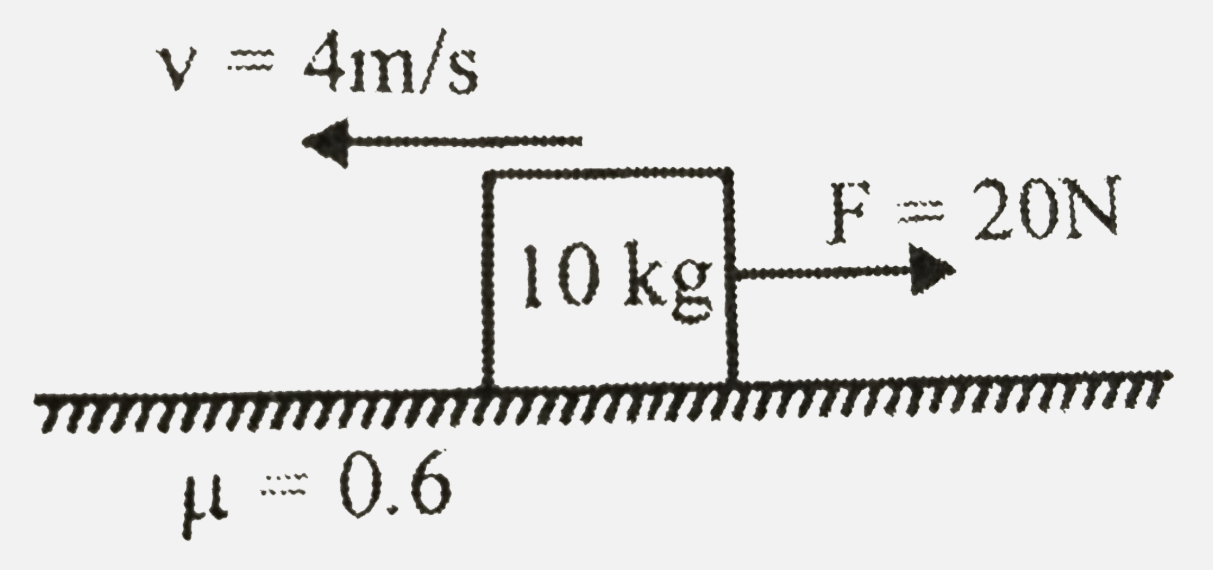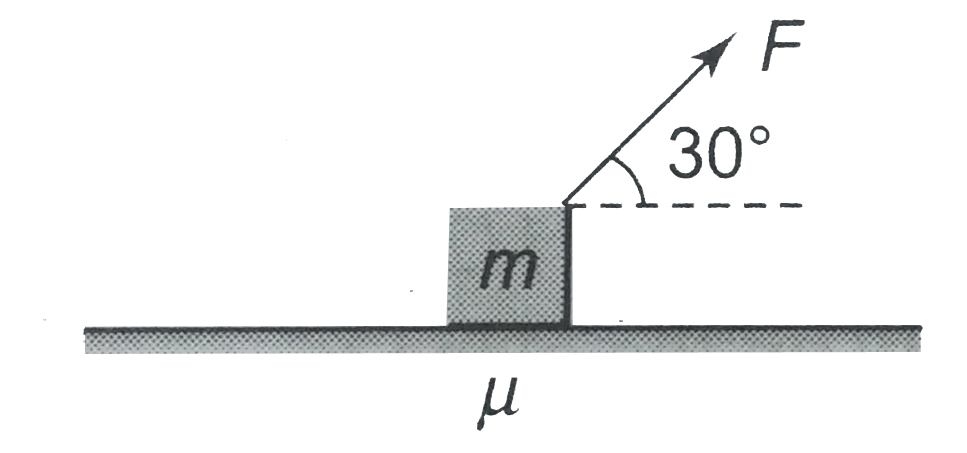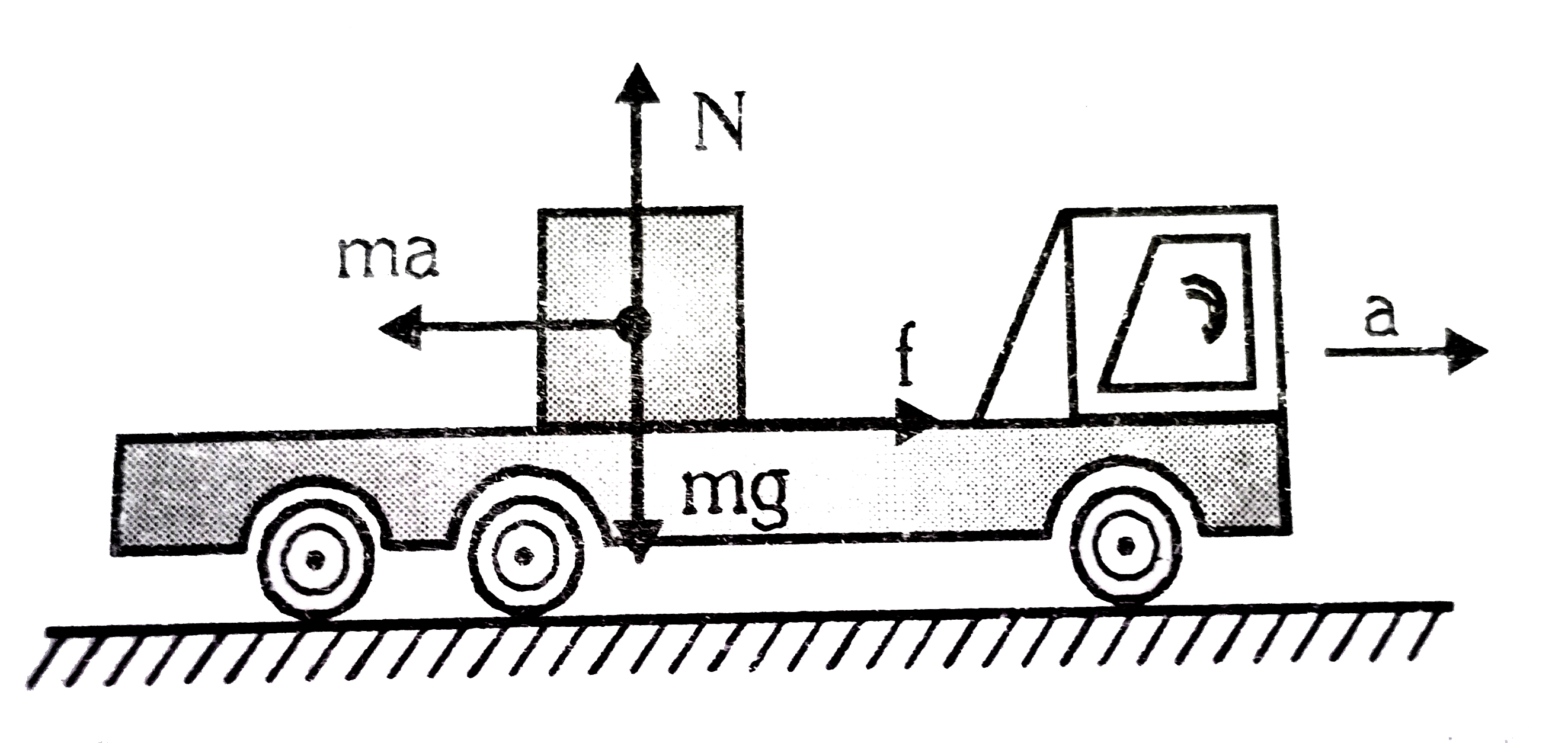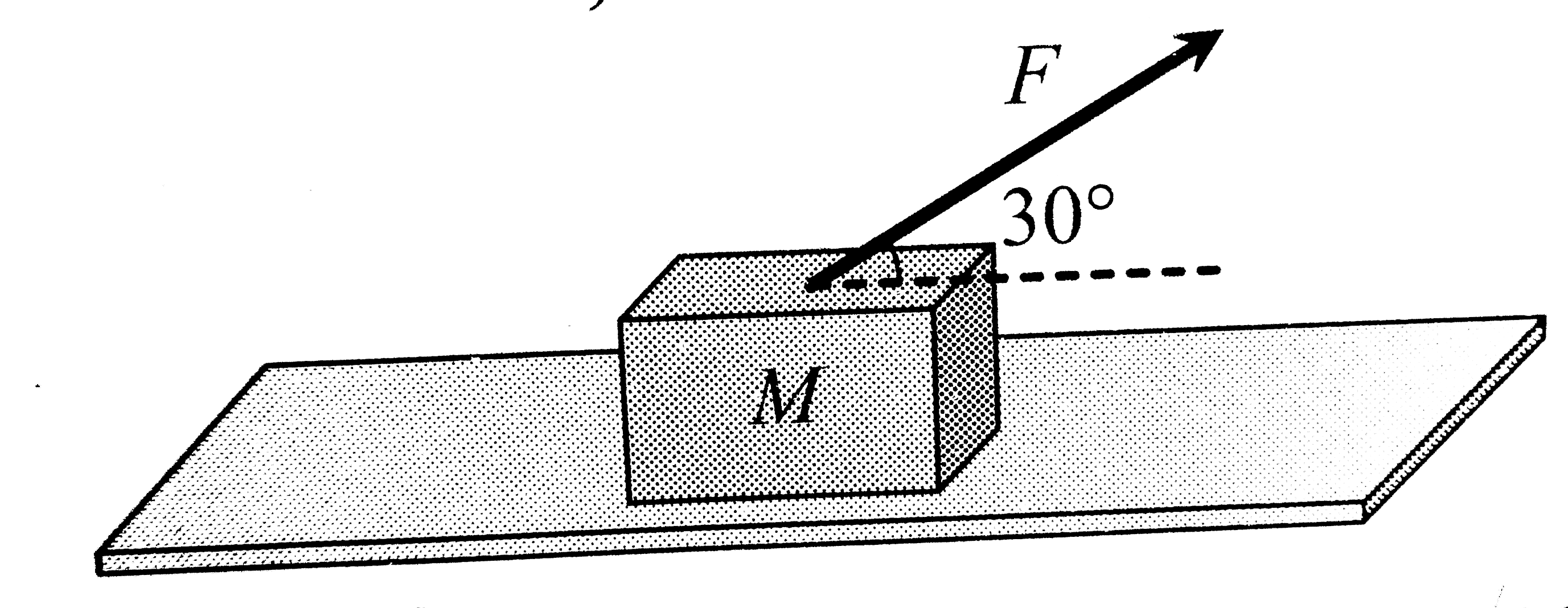A block of 10kg mass is thrown on a rough surface having friction coefficient 0.3 with an initial speed of 5 m/s. Find the amount by which the internal energy of the blocked and the surface will increase. If this block is seen from a frame moving at a speed of 5 m/s in the direction of its velocity it is observed that the block is gently put on the rough surface moving in opposite direction at speed 5 m/s. Find the gain kinetic energy of the block as seen from this frame.
The correct Answer is:125J, 125J
To solve the problem step by step, we will break it into two parts as described in the question.
Part 1: Change in Internal Energy
1. Identify the initial kinetic energy of the block:
The formula for kinetic energy (KE) is given by:
KE=12mv2
where m is the mass and v is the velocity.
Given:
- Mass m=10kg
- Initial velocity v=5m/s
Substituting the values:
KEinitial=12×10×(5)2=12×10×25=125J
2. Determine the final kinetic energy of the block:
When the block comes to rest, its final velocity is 0m/s. Therefore, the final kinetic energy is:
KEfinal=12×10×(0)2=0J
3. Calculate the change in kinetic energy:
The change in kinetic energy (ΔKE) is given by:
ΔKE=KEfinal−KEinitial=0−125=−125J
4. Relate the change in kinetic energy to the change in internal energy:
The loss of kinetic energy is converted into heat energy due to friction, which increases the internal energy of the block and the surface. Thus:
ΔE=−ΔKE=125J
Part 2: Gain in Kinetic Energy from Another Frame
1. Analyze the situation from a moving frame:
In this frame, both the observer and the block are moving at the same speed of 5m/s in the same direction. Therefore, the relative velocity of the block with respect to the observer is:
vrelative=vblock−vframe=5−5=0m/s
2. Determine the initial kinetic energy in the moving frame:
Since the block appears at rest in this frame, its initial kinetic energy is:
KEinitial, frame=0J
3. Calculate the final kinetic energy in the moving frame:
If the surface is moving in the opposite direction at 5m/s, the block will eventually have a velocity of −5m/s relative to the observer. Therefore, the final kinetic energy is:
KEfinal, frame=12×10×(−5)2=12×10×25=125J
4. Calculate the gain in kinetic energy:
The gain in kinetic energy (ΔKEframe) is:
ΔKEframe=KEfinal, frame−KEinitial, frame=125−0=125J
Final Answers
- The increase in internal energy of the block and surface is 125 J.
- The gain in kinetic energy of the block as seen from the moving frame is 125 J.
The formula for kinetic energy (KE) is given by:
KE=12mv2
where m is the mass and v is the velocity.
- Mass m=10kg
- Initial velocity v=5m/s
KEinitial=12×10×(5)2=12×10×25=125J
When the block comes to rest, its final velocity is 0m/s. Therefore, the final kinetic energy is:
KEfinal=12×10×(0)2=0J
The change in kinetic energy (ΔKE) is given by:
ΔKE=KEfinal−KEinitial=0−125=−125J
The loss of kinetic energy is converted into heat energy due to friction, which increases the internal energy of the block and the surface. Thus:
ΔE=−ΔKE=125J
In this frame, both the observer and the block are moving at the same speed of 5m/s in the same direction. Therefore, the relative velocity of the block with respect to the observer is:
vrelative=vblock−vframe=5−5=0m/s
Since the block appears at rest in this frame, its initial kinetic energy is:
KEinitial, frame=0J
If the surface is moving in the opposite direction at 5m/s, the block will eventually have a velocity of −5m/s relative to the observer. Therefore, the final kinetic energy is:
KEfinal, frame=12×10×(−5)2=12×10×25=125J
The gain in kinetic energy (ΔKEframe) is:
ΔKEframe=KEfinal, frame−KEinitial, frame=125−0=125J
- The increase in internal energy of the block and surface is 125 J.
- The gain in kinetic energy of the block as seen from the moving frame is 125 J.
Topper's Solved these Questions
- BOOK - PHYSICS GALAXY - ASHISH ARORACHAPTER - HEAT AND THERMAL EXPANSIONEXERCISE - ADVANCE MCQs WITH ONE OR MORE OPTIONIS CORRECT24videos
HEAT AND THERMAL EXPANSION
- BOOK - PHYSICS GALAXY - ASHISH ARORACHAPTER - GEOMETRICAL OPTICSEXERCISE - Unsolved Numerical Problems107videos
GEOMETRICAL OPTICS
- BOOK - PHYSICS GALAXY - ASHISH ARORACHAPTER - HEAT TRANSFER EXERCISE - Unsolved Numerical Problems for Preparation of NSEP,INPhO&IPhO66videos
HEAT TRANSFER
Similar Questions
A block of mass 10 kg is moving on a rough surface as shown in figure. The frictional force acting on block is :-
 View Solution
View SolutionA block begins to move on a rough horizontal surface with an initial velocity u. If it loses of its initial kinetic energy in time t, the coefficient of kinetic friction between the block and the surface is
View Solution
Knowledge Check
- Question 1 - Select One
A block of mass 10kg is placed on a rough horizontal surface having coefficient of friction μ=0.5 . If a horizontal force of 100N is acting on it, then acceleration of the will be.
A0.5m/s2B5m/s2C10m/s2D15m/s2 - Question 2 - Select One
A block of mass m lying on a rough horizontal surface of friction coefficient μ is pulled by a force F as shown , the limiting friction between the block and surface will be
 AμmgBμ(mg+F2)Cμ(mg−F2)Dμ(mg−√3F2)
AμmgBμ(mg+F2)Cμ(mg−F2)Dμ(mg−√3F2) - Question 3 - Select One
A block of mass m is at rest on a rough inclined plane, whose friction coefficient is μ. Net force exerted by surface on block is :-
AmgBmg sin θCμmgcosθDμmgsinθ
A block of mass 1kg lies on a horizontal surface in a turck, the coefficient of static fricition between the block and the surface is 0.6, what is the force of fricition on the block. If the acceleration of the truck is 5m/s2.
 View Solution
View SolutionA block of mass m is pulled by a constant powert P placed on a rough horizontal plane. The friction coefficient the block and surface is μ. The maximum velocity of the block is.
View SolutionA block of mass m=5kg is resting on a rough horizontal surface for which the coefficient of friction is 0.2 . When a force F=40N is applied, the acceleration of the block will be (g=10m/s2) .
 View Solution
View SolutionA block of mass 5 kg slides down a rough inclined surface. The angle of inclination is 45∘. The coefficient of sliding friction is 0.20. When the block slides 10 cm, the work done on the block by force of friction is
View SolutionA block of mass 5kg is lying on a rough horizontal surface. The coefficient of static and kinetic friction are 0.3 and 0.1 and 10m/s−2. If a horizontal force of 50N is applied on the block, the frictional force is
View Solution

